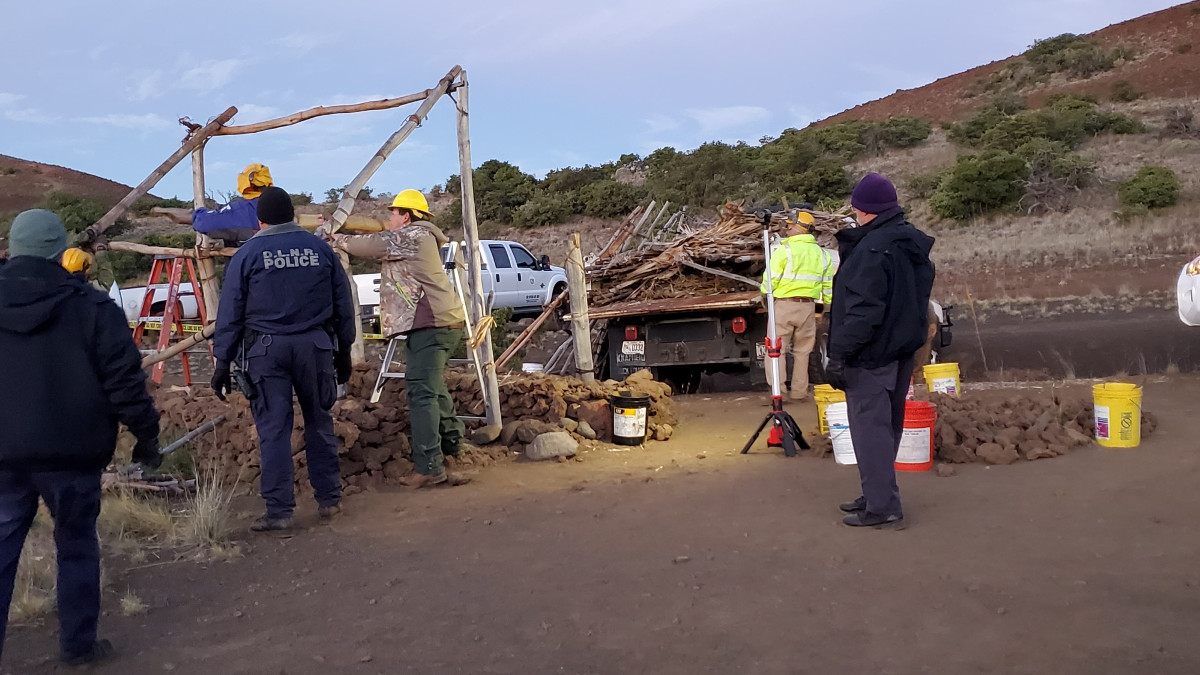(BIVN) – On Monday, the Hawaiʻi County Council Finance Committee dove into the ongoing Mauna Kea dispute, requesting a report from the administration “regarding the extent of county agency activity” on the mountain.
Councilmember Matt Kanealiʻi-Kleinfelder made the request, “due to the tremendous amount of calls and contacts” made to his office by the community, a previous media release stated. It was the first time the council put the topic of the Thirty Meter Telescope on the agenda for discussion.
Mayor Harry Kim came without a report, but instead opted to share the latest version of his Maunakea vision statement, which he said has undergone multiple drafts.
Kanealiʻi-Kleinfelder tried to focus the mayor on the details of the County’s involvement, especially in regards to recent and future law enforcement actions on the mountain.
On June 20, state and county law enforcement ascended Mauna Kea to take down two ʻahu, or stone shrines, which were placed on the site of the planned Thirty Meter Telescope back in 2015.

image courtesy Leinaʻala Sleightholm
Officers also took down Hale Kukiaʻimauna at the mid-level area, and the Hale Kūhiō ranger station on Hawaiian Home Lands next to the Mauna Kea Access Road below. Hours after the structures were dismantled, state officials held a press conference to announce the TMT project has been granted a Notice To Proceed with construction on the mountain.
“Can the county close off access to the Mauna Kea Access Road or to Saddle Road?” Kanealiʻi-Kleinfelder asked Mayor Kim, concerned about jurisdictional issues. “Is that something that we can do? And is that something that the county can do; or the state?”
“I think in a state of emergency, we can,” Mayor Kim answered.
“As law enforcement, our job is to avoid any confrontation as much as possible and seek a peaceful resolution,” Hawaiʻi County Police Chief Paul Ferreira told the council. “We fully support Mayor Kim’s vision for Mauna Kea. We also support his ongoing discussions with various entities across the state seeking a peaceful resolution. However, as the primary law enforcement agency for Hawaiʻi County, we have jurisdiction over federal, state, and county roads and lands – and the authority to take enforcement action in certain aspects.
Chief Ferreira said the police can also shut down Saddle Road. “Anytime there’s an accident on Saddle Road, if there’s a natural disaster on Saddle Road,” Ferreira said. “If there’s a natural disaster or anything happening throughout the island, we have the authority in the interest of public safety to shut the road down. If someone in the community is in danger, we have the authority to shut it down. In the event that we needed to shut down Daniel K. Inouye Highway, all our planning, all of what we’re looking at is going to be dictated by what happens by the protectors / protesters, and will be in the best interest of the community. The safety for the community, the protectors, the protesters, and… the construction workers, and more so our law enforcement officers that are on scene.”
“As far as costs, what are we looking at – again, that is an unknown,” Ferreira said. “If nothing happens there’s no cost. If something does occur and we do need to activate there’s gonna be a cost associated with it. Are we prepared to go out and respond to this event and respond to regular patrol duties? Yes. As you saw, with the volcanic eruption in Leilani Estates, we shifted our officers in two districts to 12-hour shifts, which allowed us to place officers in the field at that volcanic event, as well as placing them out on the road during their daily operations. Would this happen in the same sense? Yes, we would have to go to 12-hour shifts. Which districts would be affected? Could be the entire island, depending on what the numbers we need.”
“You’re asking about how we’re going to keep track of it?” Ferreira told Kanealiʻi-Kleinfelder. “Same way we keep track of any large-scale event. We keep a separate tally. This is what it’s costing the county, outside normal operating hours, for overtime, for salaries and wages, what-have-you. For equipment, if needed.”
“Is that reimbursable?” Ferreira continued. “Possibly, maybe not, I don’t know. Is some of it coming from the state? More than likely. Is some of it coming from federal government? I don’t believe so. This is not a FEMA activation of any type so I don’t believe that would come into play.”
“Are the police officers given a choice in the matter,” Kanealiʻi-Kleinfelder asked the chief, “if they want to work these shifts or not?”
“No,” the chief answered. “We don’t take a position, as far as law enforcement being pro or anti. But we do have to do our duty and we did take an oath of office to enforce the laws of the state.”

by Big Island Video News10:58 pm
on at
STORY SUMMARY
HILO, Hawaiʻi - Puna councilman Matt Kanealiʻi-Kleinfelder questioned Mayor Harry Kim and Police Chief Paul Ferreira about law enforcement actions in support of the Thirty Meter Telescope project.